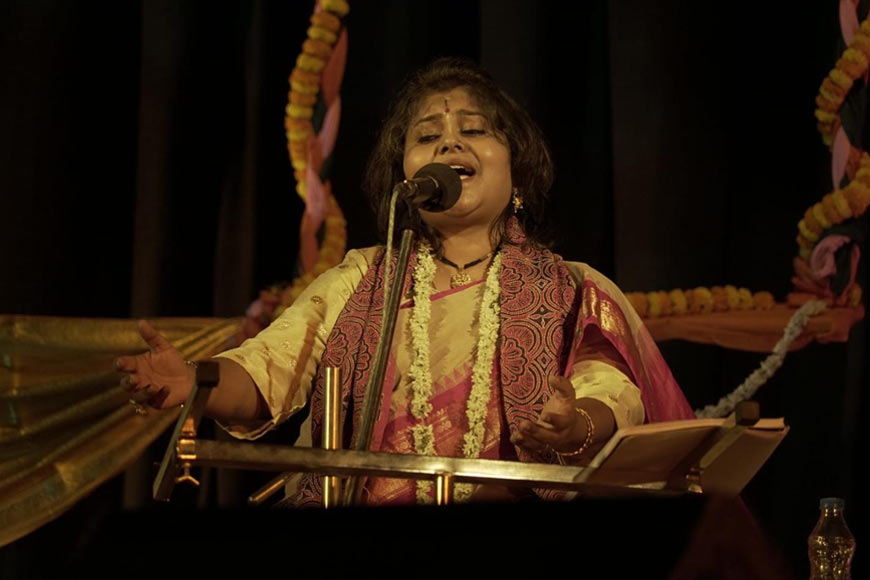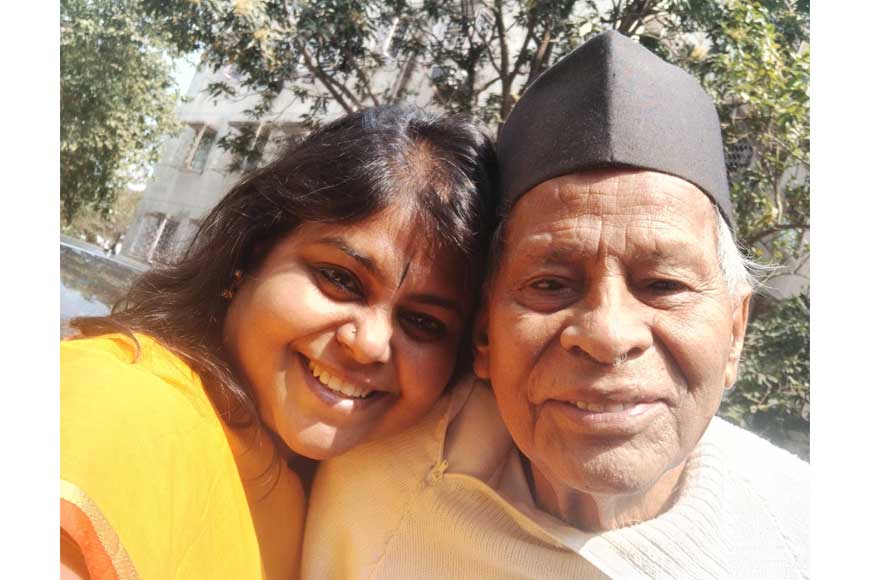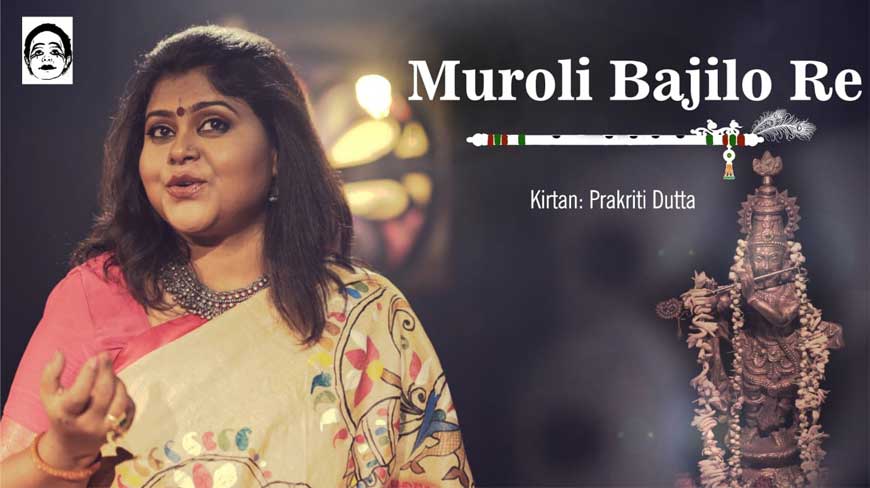Reviving the Bengali kirtan, the music of Chaitanya Mahaprabhu

The word ‘kirtan’ may conjure up different kinds of music for people from different parts of India. For most Bengalis, a kirtan is inextricably linked to the Vaishnava tradition as propagated by Chaitanya Mahaprabhu. However, musically speaking, most people probably wouldn’t link a kirtan to a Hindustani classical raga. And yet, that is exactly the link that Prakriti Dutta focuses on. What’s more, her passion for kirtan developed not during her years learning music in Bengal, but during the time she spent as a researcher in the UK, but more on that later.
Gradually, Prakriti began interspersing her own Dhrupad presentations with kirtans, both as a way to display the results of the grant she had received, and to show her audiences that classical-music based kirtans were not necessarily technically challenging for the ordinary listener. In fact, emotions, not technicalities, take precedence in a kirtan.
Daughter of legendary mime artist Jogesh Dutta, Prakriti is a classically trained vocalist specialising in the Dhrupad style, and her current project is the seven Bengali kirtans she has compiled into the album ‘Murali Bajilo Re’. The title derives from a Krishna Vandana written by 16th-century Vaishnava poet Govinda Das. Among others who have collaborated with Prakriti on the album, which is for digital release only, is renowned theatre personality Debshankar Haldar, who has narrated the introduction (what a kirtaniya would call ‘gourchandra’) to each song.
 Prakriti with her father Jogesh Dutta
Prakriti with her father Jogesh Dutta
“The Bengali style kirtan is as old as Mahaprabhu, which makes it at least 500 years old,” says Prakriti. “But its root lies in the Dhrupad style (the only Indian classical musical form to have originated in Bengal).” The reason for this, she says, is that Narottam Das, the man who introduced kirtan into Bengal about 50 years after Mahaprabhu’s passing in 1534, spent a long time in Vrindavan, where he associated with the likes of Tansen (Emperor Akbar’s legendary court musician) and Swami Haridas (the spiritual poet and classical musician whose work influenced both the classical music and the Bhakti movements of North India).
Her passion dates back to the time when she travelled to Edinburgh to study music therapy and communication, and later shifted to London and took part in a couple of operatic performances in which she featured as a Dhrupad singer. It was in London that she discovered the ISKCON centre in Soho Street, and its kirtaniyas, both men and women. “I was astounded by the skill and dedication of these foreigners, who genuinely loved their art and wanted to get better at it.
How much of modern Bengali kirtan follows classical tenets? Prakriti ruefully admits that the link has grown ever weaker with the passing of time. Outstanding kirtan practitioners of Bengal, such as Rathin Ghosh, Nabadwip Brajabasi, or Chhabi Bandyopadhyay were deeply rooted in their classical training, but their modern counterparts have not really adhered to tradition. “Owing to a lack of classical training, modern singers have done away with the classical elements,” says Prakriti. “Earlier, depending on time of day, a kirtan would be set to a suitable raga. So if you were singing early in the morning, you would have to follow a morning raga like Ahir Bhairav, for instance. Now, you are most likely to hear a kirtan set to the ‘Tumpa’ song or a Bollywood song, with people hurriedly closing their windows!”
Kirtan isn’t simply music, but the reflection of a certain way of life, which is perhaps difficult to stick to in these modern times. Nonetheless, Prakriti explores her passion for the form by musically remaining as true to tradition as possible. Broadly speaking, the history of ‘pala kirtan’ (similar to a musical play) dates back to when Narottam Das sensed that after the demise of Mahaprabhu and other leading proponents of Vaishnavism in Bengal, the community would have to be held together by a mass-based, inclusive programme. The solution he hit upon was the ‘pala kirtan’, depicting episodes from the life of Lord Krishna. “He almost used it like a tool to get Vaishnavas to gather,” says Prakriti.
Her own view of the kirtan is that it is a beautiful musical form, unfortunately reduced to an obscure, archaic art in our times, owing to a lack of skilled practitioners and proper presentation. Which is what she seeks to remedy in her album.
Her passion dates back to the time when she travelled to Edinburgh to study music therapy and communication, and later shifted to London and took part in a couple of operatic performances in which she featured as a Dhrupad singer. It was in London that she discovered the ISKCON centre in Soho Street, and its kirtaniyas, both men and women. “I was astounded by the skill and dedication of these foreigners, who genuinely loved their art and wanted to get better at it. Some of them even came to me for harmonium lessons,” she says. “Just imagine, I was a music scholar from Rabindra Bharati, where I had been taught two kirtans, yet I was simply clueless about how rich the tradition was, or how classically enriched. I had to learn that from foreigners.”
Also read : Bhorai Kirtan – The dying music of Burdwan
On her return to Kolkata in 2015, she signed up for a research project being conducted by the Asiatic Society on the history of the kirtan. Fuelling her growing passion was her association with Nimai Mitra, the octogenarian ‘Srikhol’ player who has accompanied the best Bengali kirtaniyas of the last 50 years. It was he who showed Prakriti how Dhrupad and kirtan blended seamlessly.

In 2016, she applied for a junior research fellowship from the Indian government on the topic of the evolution of Goudiya kirtan from Dhrupad. The grant enabled her to make four field trips to Vrindavan, where she came upon the still existing tradition of the ‘samaj kirtan’ in various temples. “And the style is completely classical,” she says. “There are temples where they say that the deity can do without food, but not without classical music!”
How much of modern Bengali kirtan follows classical tenets? Prakriti ruefully admits that the link has grown ever weaker with the passing of time. Outstanding kirtan practitioners of Bengal, such as Rathin Ghosh, Nabadwip Brajabasi, or Chhabi Bandyopadhyay were deeply rooted in their classical training, but their modern counterparts have not really adhered to tradition.
Gradually, Prakriti began interspersing her own Dhrupad presentations with kirtans, both as a way to display the results of the grant she had received, and to show her audiences that classical-music based kirtans were not necessarily technically challenging for the ordinary listener. In fact, emotions, not technicalities, take precedence in a kirtan. Her album, too, bears ample evidence of this, and has already drawn the interest of various digital platforms such as Spotify. ‘Murali Bajilo Re’ could even stand as a testament to communal harmony, since some of the composers that Prakriti has chosen were Muslim poets composing quintessentially Vaishanva songs, but that subject merits a story in itself.
On Poila Baisakh, there could perhaps be no better way of reinforcing one’s ties with Bengal than a few minutes spent listening to the traditional, beautiful Bengali kirtan.











